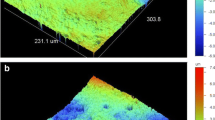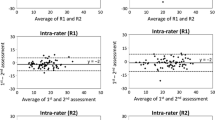Abstract
Objectives
To test 8 models of linear surface roughness assessment in characterizing surface profile description and to correlate these models with equivalent areal parameters over sound human enamel in vitro.
Materials and methods
Thirty enamel blocks were randomly selected. The roughness data (2D—Rp; Rv; Rz; Rc; Rt; Ra; Rq; Rsk; Rku/3D—Sp; Sv; Sz; Sa; Sq; Ssk; Sku) was obtained in duplicate in a non-contact 3D optical profilometer. The models were composed by 1 single vertical trace (model 1) until 8 traces (model 8 composed by three vertical traces, three horizontal traces, and two diagonal).
Results
The addition of linear sampling traces to the enamel blocks did not result in Rp, Rv, Rz, Rc, Rt, Ra, Rq, Rsk, and Rku value changes (low power—from 5 to 72%). Significant Spearman’s correlation coefficients were obtained in most correlation analysis (Rp ↔ Sp; Rv ↔ Sv; Rz ↔ Sz; Ra ↔ Sa; Rq ↔ Sq; and Rku ↔ Sku).
Conclusions
A single vertical trace in the middle of the sample was representative of the overall enamel surface roughness (Rp, Rv, Rz, Rc, Rt, Ra, Rq, Rsk, and Rku) models. The majority of the assessed models in the correlation evaluation presented significant and positive association.
Clinical relevance
The findings highlight the applicable model for roughness analysis over human enamel recommended for research and in situ trials assessments.

Similar content being viewed by others
References
Schlueter N, Amaechi BT, Bartlett D et al (2020) Terminology of erosive tooth wear: consensus report of a workshop organized by the ORCA and the Cariology Research Group of the IADR. Caries Res 54:2–6. https://doi.org/10.1159/000503308
Carvalho TS, Colon P, Ganss C et al (2015) Consensus report of the European Federation of Conservative Dentistry: erosive tooth wear—diagnosis and management. Clin Oral Investig 19:1557–1561. https://doi.org/10.1007/s00784-015-1511-7
Kreulen CM, Van ’t Spijker A, Rodriguez JM, Bronkhorst EM, Creugers NH, Bartlett DW (2010) Systematic review of the prevalence of tooth wear in children and adolescents. Caries Res 44:151–159. https://doi.org/10.1159/000308567
Stangvaltaite-Mouhat L, Pūrienė A, Stankeviciene I, Aleksejūnienė J (2020) Erosive tooth wear among adults in Lithuania: a cross-sectional national oral health study. Caries Res 54:283–291. https://doi.org/10.1159/000509872
Büyükyilmaz T, Ogaard B, Rølla G (1997) The resistance of titanium tetrafluoride-treated human enamel to strong hydrochloric acid. Eur J Oral Sci 105:473–477. https://doi.org/10.1111/j.1600-0722.1997.tb00233.x
Schlueter N, Ganss C, Mueller U, Klimek J (2007) Effect of titanium tetrafluoride and sodium fluoride on erosion progression in enamel and dentine in vitro. Caries Res 41:141–145. https://doi.org/10.1159/000098048
Wiegand A, Schneider S, Sener B, Roos M, Attin T (2014) Stability against brushing abrasion and the erosion-protective effect of different fluoride compounds. Caries Res 48:154–162. https://doi.org/10.1159/000353143
Comar LP, Cardoso CAB, Charone S, Grizzo LT, Buzalaf MAR, Magalhães AC (2015) TiF4 and NaF varnishes as anti-erosive agents on enamel and dentin erosion progression in vitro. J Appl Oral Sci 23:14–18. https://doi.org/10.1590/1678-775720140124
Magalhães AC, Santos MG, Comar LP, Buzalaf MAR, Ganss C, Schlueter N (2016) Effect of a single application of TiF4 varnish versus daily use of a low-concentrated TiF4 /NaF solution on tooth erosion prevention in vitro. Caries Res 50:462–470. https://doi.org/10.1159/000448146
Souza BM, Vertuan M, Buzalaf MAR, Magalhães AC (2017) The impact of the demineralized organic matrix on the effect of TiF4 varnish on the progression of dentin erosive loss. Caries Res 51:264–270. https://doi.org/10.1159/000475534
Souza BM, Santi LRP, Silva MS, Buzalaf MAR, Magalhães AC (2018) Effect of an experimental mouth rinse containing NaF and TiF4 on tooth erosion and abrasion in situ. J Dent 73:45–49. https://doi.org/10.1016/j.jdent.2018.04.001
Medeiros MID, Carlo HL, Santos RL, Sousa FB, Castro RD, França RCS, Carvalho FG (2018) TiF4 varnish protects the retention of brackets to enamel after in vitro mild erosive challenge. J Appl Oral Sci 26:e20170222. https://doi.org/10.1590/1678-7757-2017-0222
Justino IBS, Alexandria AK, Canto FMT, Leite KLF, Vieira TI, Cabral LM, Silva RF, Maia LC (2020) Comparative effect of calcium mesoporous silica versus calcium and/or fluoride products on the reduction of erosive tooth wear and abrasive enamel lesion. Pesqui Bras Odontopediatria Clín Integr 20:e0025. https://doi.org/10.1590/pboci.2020.146
Canto FMT, Alexandria AK, Vieira TI, Justino IBS, Cabral LM, Silva RF, Maia LC (2020) Comparative effect of calcium mesoporous silica versus calcium and/or fluoride products against dental erosion. Braz Dent J 31:164–170. https://doi.org/10.1590/0103-6440202002557
Levy FM, Rios D, Buzalaf MAR, Magalhães AC (2014) Efficacy of TiF4 and NaF varnish and solution: a randomized in situ study on enamel erosive–abrasive wear. Clin Oral Investig 18:1097–1102. https://doi.org/10.1007/s00784-013-1096-y
Oliveira TA, Scaramucci T, Nogueira FN, Simões A, Sobral MAP (2015) Effect of mouthrinses with different active agents in the prevention of initial dental erosion. Indian J Dent Res 26:508–513. https://doi.org/10.4103/0970-9290.172052
Medeiros MID, Carlo HL, Lacerda-Santos R, Lima BAG, Sousa FB, Rodrigues JA, Carvalho FG (2016) Thickness and nanomechanical properties of protective layer formed by TiF4 varnish on enamel after erosion. Braz Oral Res 30:S1806-83242016000100260. https://doi.org/10.1590/1807-3107BOR-2016.vol30.0075
Alexandria AK, Vieira TI, Pithon MM, Fidalgo TKS, Fonseca-Gonçalves A, Valença AMG, Cabral LM, Maia LC (2017) In vitro enamel erosion and abrasion-inhibiting effect of different fluoride varnishes. Arch Oral Biol 77:39–43. https://doi.org/10.1016/j.archoralbio.2017.01.010
Mantilla TF, Silva CV, Ramos-Oliveira TM, Turssi CP, Ribeiro MS, Freitas PM (2017) TiF4 gel effects on tubular occlusion of eroded/abraded human dentin. Microsc Res Tech 80:1182–1188. https://doi.org/10.1002/jemt.22915
Mantilla TF, Turssi CP, Ramos-Oliveira TM, Silva CV, Suzuki LC, Freitas PM (2017) The in situ effect of titanium tetrafluoride gel on erosion/abrasion progression in human dentin. Braz Dent J 28:337–345. https://doi.org/10.1590/0103-6440201601247
Alexandria AK, Meckelburg NA, Puetter UT, Salles JT, Souza IPR, Maia LC (2016) Do pediatric medicines induce topographic changes in dental enamel? Braz Oral Res 30:S1806-83242016000100210. https://doi.org/10.1590/1807-3107BOR-2016.vol30.0011
Moda MD, Briso ALF, Oliveira RP, Pini NIP, Gonçalves DFM, Santos PH, Fagundes TC (2020) Effects of different toothpastes on the prevention of erosion in composite resin and glass ionomer cement enamel and dentin restorations. J Appl Oral Sci 28:e20200493. https://doi.org/10.1590/1678-7757-2020-0493
Passos VF, Sousa RBRA, Melo MAS, Gomes EAB, Santiago SL, Lima JPM (2021) In vitro effect of children’s toothpaste on brushing abrasion of eroded primary enamel. Eur Arch Paediatr Dent 22:157–162. https://doi.org/10.1007/s40368-020-00536-8
Leal IC, Costa WKF, Passos VF (2020) Fluoride dentifrice containing calcium silicate and sodium phosphate salts on dental erosion: in vitro study. Arch Oral Biol 118:104857. https://doi.org/10.1016/j.archoralbio.2020.104857
Danesh G, Podstawa PKK, Schwartz C-E, Kirschneck C, Bizhang M, Arnold WH (2020) Depth of acid penetration and enamel surface roughness associated with different methods of interproximal enamel reduction. PLoS ONE 15:e0229595. https://doi.org/10.1371/journal.pone.0229595
Babina K, Polyakova M, Sokhova I, Doroshina V, Arakelyan M, Novozhilova N (2020) The effect of finishing and polishing sequences on the surface roughness of three different nanocomposites and composite/enamel and composite/cementum interfaces. Nanomaterials 10:1339. https://doi.org/10.3390/nano10071339
Bhushan B (2001) Surface roughness analysis and measurement techniques. In: Bhushan B (ed) Modern tribology handbook, 1st edn. CRC Press LLC, pp 1–71
Adamczak S, Zmarzły P (2019) Research of the influence of the 2D and 3D surface roughness parameters of bearing raceways on the vibration level. J Phys Conf Ser 1183:012001. https://doi.org/10.1088/1742-6596/1183/1/012001
Gadelmawla ES, Koura MM, Maksoud TMA, Elewa IM, Soliman HH (2002) Roughness parameters. J Mater Process Technol 123:133–145. https://doi.org/10.1016/S0924-0136(02)00060-2
Hjortsjö C, Jonski G, Young A, Saxegaard E (2014) Etching effect of acidic fluorides on human tooth enamel in vitro. Arch Oral Biol 59:1328–1333. https://doi.org/10.1016/j.archoralbio.2014.08.007
Chan YH (2003) Biostatistics 104: correlational analysis. Singapore Med J 44:614–619
Conroy M, Armstrong J (2005) A comparison of surface metrology techniques. J Phys Conf Ser 13:458–465. https://doi.org/10.1088/1742-6596/13/1/106
Szyszka A, Wośko M, Szymański T, Paszkiewicz R (2016) Surface topography analysis with application of roughness area dependence method. Ultramicroscopy 170:77–85. https://doi.org/10.1016/j.ultramic.2016.07.017
Mullan F, Austin RS, Parkinson CR, Hasan A, Bartlett DW (2017) Measurement of surface roughness changes of unpolished and polished enamel following erosion. PLoS ONE 12:e0182406. https://doi.org/10.1371/journal.pone.0182406
Antonio PD, Lasalvia M, Perna G, Capozzi V (2012) Scale-independent roughness value of cell membranes studied by means of AFM technique. Biochim Biophys Acta (BBA)-Biomembr 1818:3141–3148. https://doi.org/10.1016/j.bbamem.2012.08.001
Field J, German M, Waterhouse P (2013) Using bearing area parameters to quantify early erosive tooth surface changes in enamel: a pilot study. J Dent 41:1060–1067. https://doi.org/10.1016/j.jdent.2013.08.015
Field JC, Waterhouse PJ, German MJ (2017) The early erosive and abrasive challenge: a profilometric, electron microscopic and microhardness study using human, bovine and ovine enamel. Eur J Prosthodont Restor Dent 25:93–100. https://doi.org/10.1922/EJPRD_01660Field08
Perchyonok VT, Souza J, Küll MF, Suzuki TYU, Maluly-Proni AT, Santos PHD (2019) Color stability and surface roughness of chitosan- and nanodiamond-modified bisacrylic resin. Braz Oral Res 33:e024. https://doi.org/10.1590/1807-3107bor-2019.vol33.0024
Amaral CM, Rodrigues JA, Erhardt MC, Araujo MW, Marchi GM, Heymann HO, Pimenta LA (2006) Effect of whitening dentifrices on the superficial roughness of esthetic restorative materials. J Esthet Restor Dent 18:102–108. https://doi.org/10.2310/6130.2006.00017_1.x
Oliveira RDB, Sousa FB, Algarni AA, Eckert GJ, Hara AT (2020) Susceptibility of dental enamel of different ages to caries-like lesion development. Caries Res 54:475–482. https://doi.org/10.1159/000509461
Acknowledgements
T.I.V. is postdoctoral researcher supported by CAPES (Coordination for the Improvement of Higher Education Personnel). This study was financed in part by the Coordenação de Aperfeiçoamento de Pessoal de Nível Superior, Brasil (CAPES), finance code 001. K.M.S.A. was a student member of the Institutional Program of Scholarships to Scientific Researchers—PIBIC/CNPq/UFPB.
Funding
This study was financed in part by the Coordenação de Aperfeiçoamento de Pessoal de Nível Superior, Brasil (CAPES), finance code 001, and PIBIC/Conselho Nacional de Desenvolvimento Científico e Tecnológico/UFPB.
Author information
Authors and Affiliations
Contributions
Study concept and design: T.I.V. and A.U.D.B. Data acquisition: T.I.V. and K.M.S.A. Data analysis: T.I.V., K.M.S.A., L.M.C., A.M.G.V., L.C.M., A.U.D.B. Statistical analysis: T.I.V. and A.U.D.B. Manuscript final approval: T.I.V., K.M.S.A., L.M.C., A.M.G.V., L.C.M., A.U.D.B.
Corresponding author
Ethics declarations
Ethics approval
The research protocol was approved by the ethics committee from the Health Sciences Center of Federal University of Paraiba (Plataforma Brazil CAAE 12872819.3.0000.5188).
Informed consent
Written informed consent was obtained from all participants included in this study.
Conflict of interest
The authors declare no competing interests.
Additional information
Publisher's Note
Springer Nature remains neutral with regard to jurisdictional claims in published maps and institutional affiliations.
Rights and permissions
Springer Nature or its licensor holds exclusive rights to this article under a publishing agreement with the author(s) or other rightsholder(s); author self-archiving of the accepted manuscript version of this article is solely governed by the terms of such publishing agreement and applicable law.
About this article
Cite this article
Vieira, T.I., de Sousa Andrade, K.M., Cabral, L.M. et al. Linear and areal surface roughness assessments for the study of tooth wear in human enamel. Clin Oral Invest 27, 329–338 (2023). https://doi.org/10.1007/s00784-022-04727-z
Received:
Accepted:
Published:
Issue Date:
DOI: https://doi.org/10.1007/s00784-022-04727-z




